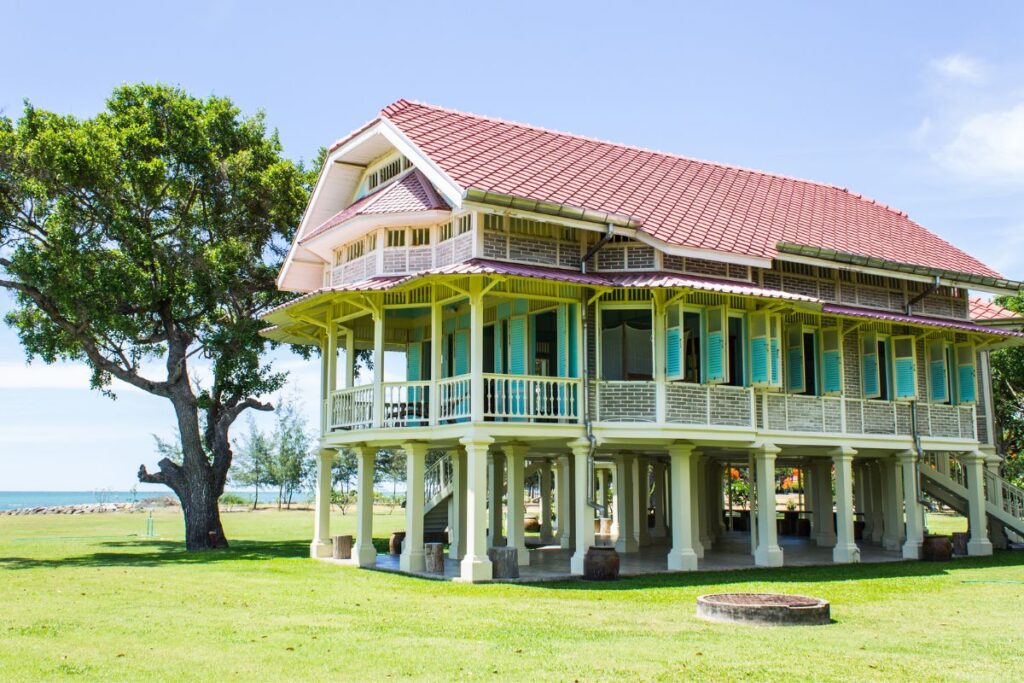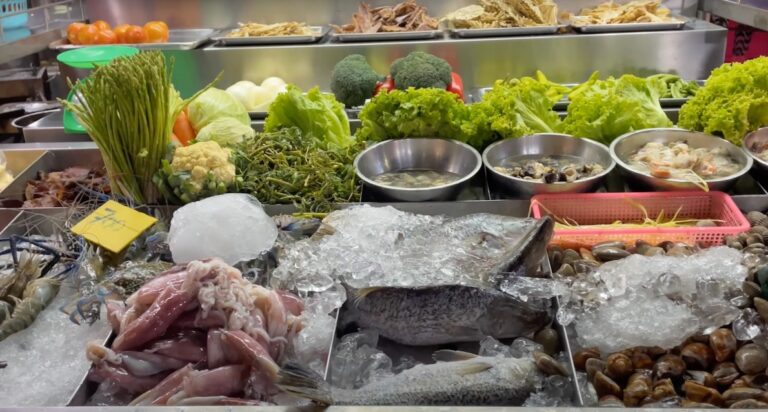Mrigadayavan Palace
Mrigadayavan (Mareukatayawan) Palace is located in a military camp on the Bang Kra coast between Cha-am and Hua Hin in the Petchaburi province. It is approximately 18 km to the north of Hua Hin. Constructed under the command of His Majesty King Vajiravudh (Rama VI) in 1923, this royal palace served as a summer retreat where he could relax in a tranquil environment.
The entire palace, built in Victorian style, is constructed entirely of teakwood and comprises sixteen pavilions divided into three groups. These pavilions are interconnected by long verandas supported by concrete posts, totaling around 1080 columns. The high ceilings and ornamentation on the walls ensure excellent ventilation with the sea breeze.

History of the Mrigadayavan Palace
The name “Mrigadayavan Palace” translates to “Palace of Love and Hope” in Thai, which is connected to Queen Indrasakdi Sati’s pregnancy. King Vajiravudh fervently hoped for the birth of an heir, but unfortunately, the queen suffered a miscarriage. However, she later gave birth to their daughter, Princess Bejaratana, at Phra Nang Chao Suvadhana just one day before he died in 1925.
The two-story Samoson Sevakamataya pavilion in the northern wing of the palace served as receptions and official ceremonies. It also features a stage for performances and entertainment.
The halls in the southern wing, known as Bisansagara, served as the king and queen’s private residence. The Royal Suite, comprising an office, bedroom, dressing room, and bathrooms, includes a bed with a white canopy. The king’s former study, where Rama VI once enjoyed composing poetry at night, now contains only a table and chair.
The Samudabiman halls formed the inner court of the palace, which was closed to men other than the king. This area served as the residence for Her Majesty Queen Indrasakdi Sati. Adjacent to the wing was a residence for her sister and entourage, along with a dining pavilion with a separate exit to the sea.
To the left of the palace stands a lush park surrounded by greenery and flowers, followed by a mangrove forest with wooden walkways.
In 1981, the Department of Fine Arts turned over 32 Rai, including the palace itself, to become a national historical museum. Restoration funds were allocated in 1983, and the restoration began in 1987, opening the palace to the public. The restoration of Mrigadayavan progressed slowly. The initial phase was completed in 1993, while the second phase began in 2004, finishing in 2008, costing 120 million baht.

Today, the Mrigadayavan Palace opens its door to visitors a few times a year. The palace floors, coated with lacquer to preserve them, require visitors to place their shoes in provided pouches to prevent damage. Photography inside the pavilions is prohibited. There’s a pavilion offering food and refreshments within the park. Bicycles are available for rent to explore the palace grounds.
How to Get to the Mrigadayavan Palace
You have two options for getting to the palace. You can hop on the local orange bus from Hua Hin night market to reach the palace. Alternatively, you can hire a taxi van in Hua Hin for a day trip to the palace.
Admission tickets cost 30 baht for adults and 15 baht for children. Visitors must ensure their shoulders and knees are covered; if not, a sarong can be rented for a 20 baht deposit. Opening hours are from 08:30 to 16:30 daily (closed on Wednesdays).
Frequently Asked Questions about the Mrigadayavan Palace
1. When was Mrigadayavan Palace built?
Mrigadayavan Palace was constructed in 1923 under the direction of King Rama VI, Chulalongkorn, as a summer retreat. It was designed by Italian architect Annibale Rigotti and inspired by Neo-Baroque and European colonial architecture.
2. What is the architecture of Mrigadayavan Palace like?
The palace is built primarily from teak wood, a durable and naturally resistant tropical hardwood. It features long colonnaded corridors, high ceilings, intricate wooden carvings, and latticework. The design incorporates both Western architectural elements, such as the colonnades and high ceilings, and traditional Thai elements, such as intricate carvings and latticework.
3. What are the highlights of Mrigadayavan Palace?
The palace’s most notable features include:
- 1,080 concrete pillars supporting the structure’s weight
- Fret patterned plaster walls with intricate designs
- High ceilings reaching up to 7 meters (23 feet)
- Elaborate wooden corridors connecting the various sections of the palace
- Unobstructed sea views from the upper floors
4. What are the hours of operation and admission fees for Mrigadayavan Palace?
The palace is open to the public a few times a year. When it’s open, you can get there from 8:30 AM to 4:30 PM. Admission is 30 baht (approximately $1) for adults and free for children under 12 years old.
5. What is the dress code for Mrigadayavan Palace?
The palace has a conservative dress code, which requires that shoulders and knees be covered. No tank tops, shorts, or flip-flops are allowed. Sarees or long skirts are available to rent for 20 baht for those who do not have appropriate attire.
6. Is Mrigadayavan Palace an active royal residence?
Yes, Mrigadayavan Palace is an active royal residence and is still used by the Royal Family on occasion. It is a property of the Crown Property Bureau. However, it is open to the public a few times a year.
7. How do I get to Mrigadayavan Palace?
Mrigadayavan Palace is located in Cha-am in Phetchaburi Province.
8. What are the other attractions in the area?
There are many other attractions in the Hua Hin area, including:
- Cha-Am Beach, a popular beach destination with white sand and clear waters
- Plearn Wan Floating Market, a traditional Thai floating market with a variety of food, souvenirs, and handicrafts
- Sala Montra, a cultural center with traditional Thai performances and exhibitions
- Khao Takiab Temple, a hilltop temple with panoramic views of the coast


